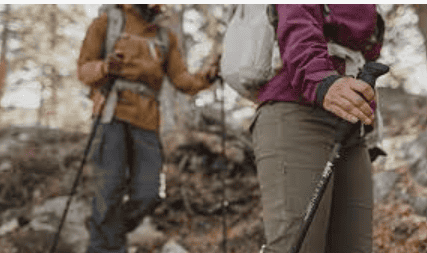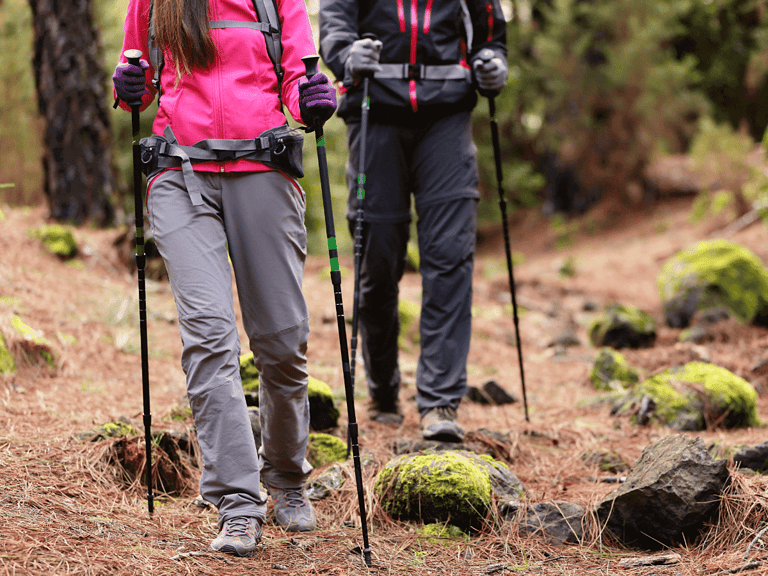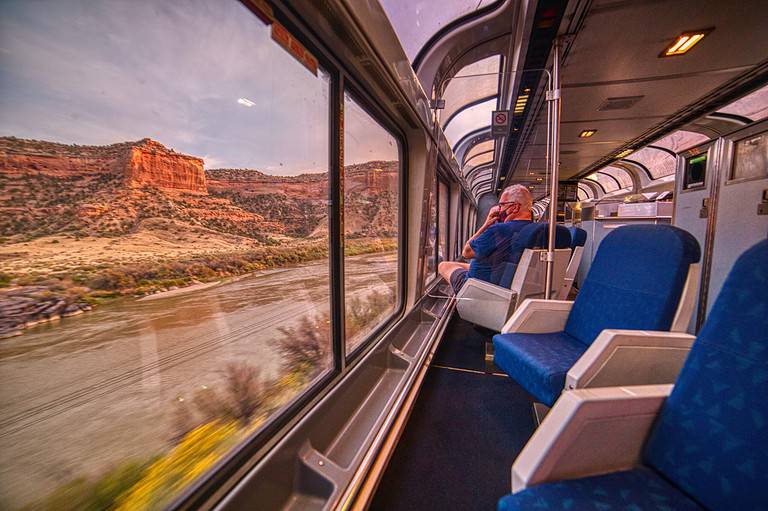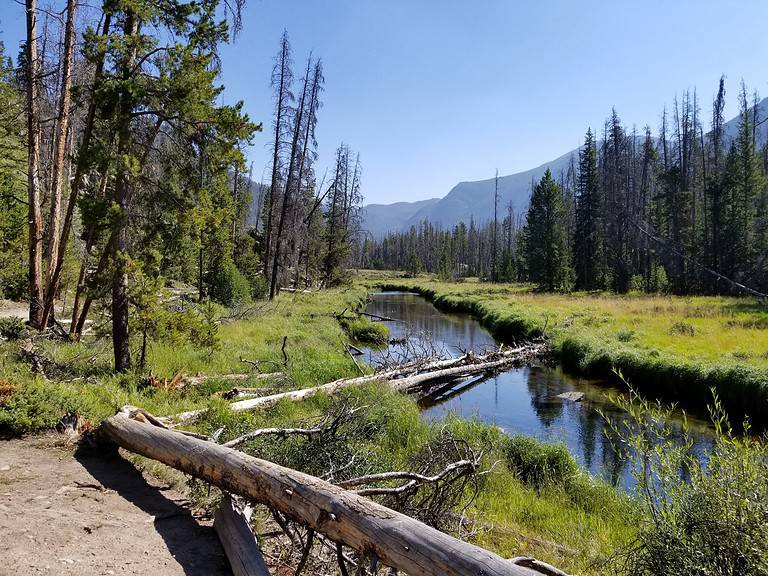92 Essential Hiker’s Items for Hiking & Camping
What are the Items that every Hiker Needs?
As a hiker, your adventure requires careful preparation; the right gear can make all the difference. No matter what level of hiker you are, just starting or experienced, this comprehensive list of 93 essential items will ensure you or your friends have everything you need for the trails. This list covers everything from sturdy footwear and reliable navigation tools to essential safety gear and comfortable backpacks.
Key Statistics on Hiking
- There are around 57.8 million hikers in the US.
- The National Trails System consists of around 193,000 hiking miles.
- The National Trails System includes 200,000 miles of trails located on federal lands.
- The National Trails System has been very beneficial, allowing for 9 million backpackers and 8 million mountain bikers on the trails alongside hikers.
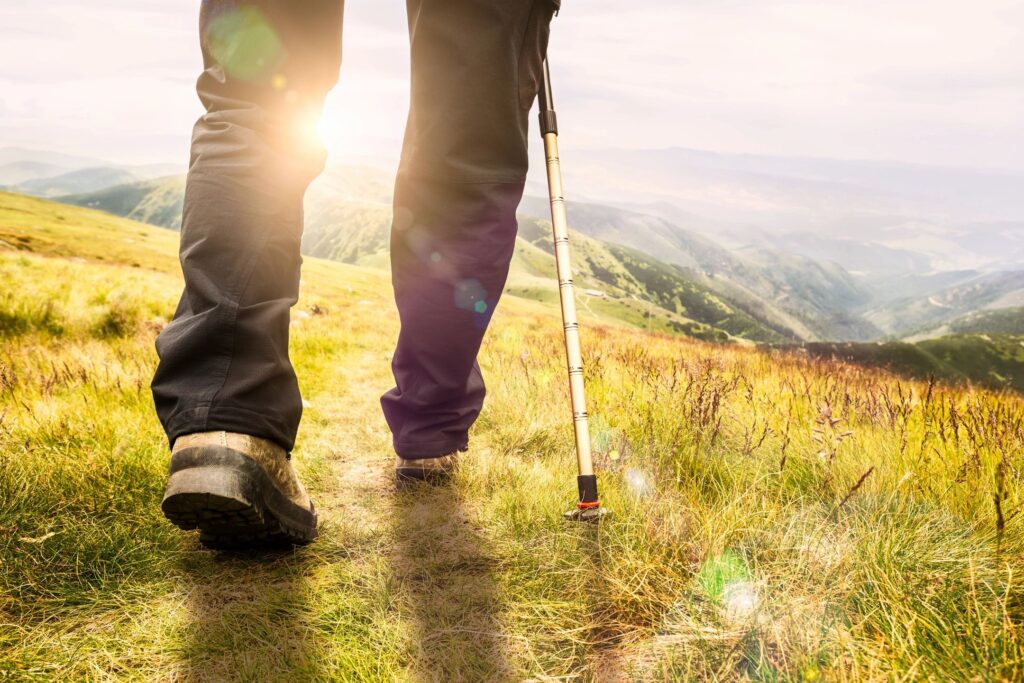
1. Hiking Boots:
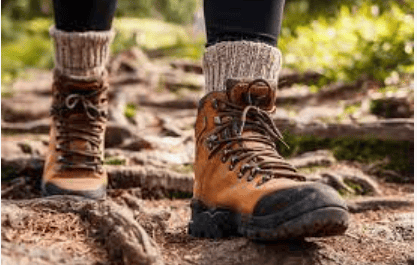
Quality hiking boots provide ankle support, protect your feet from rocks and uneven terrain, and offer traction to prevent slips and falls, ensuring a comfortable and safe hiking experience for whatever type of hiking you do, Day Hiking, Thru Hiking, or Urban Hiking. This is one of the essential must-haves for every hiker.
2. Hiking Socks:
Specially designed hiking socks with moisture-wicking properties keep your feet dry, reduce friction, and minimize the risk of blisters, ensuring optimal comfort during long hikes. Good socks equal happy feet and a good hike.
3. Backpack:
A well-fitting backpack distributes the weight of your gear evenly, reducing strain on your shoulders and back. It allows you to carry essentials like water, food, extra clothing, and gear comfortably, making it an essential hiking companion. Getting a backpack that fits you well and has comfortable straps is vital.
4. Hiking Poles:
Hiking poles provide stability and support, especially on challenging terrains, steep inclines, and descents. They help reduce strain on your knees and joints, improve balance, and provide an extra push during ascents, making your hike more enjoyable and efficient. These can be game-changers for those who hike a lot of rocky, mountain-type terrains.
5. Navigation Tools:
Carrying a map, compass, or GPS device ensures you stay aware of your destination safely. These tools help you navigate trails, find alternate routes, and avoid getting lost, enhancing your hiking experience and promoting confidence in your abilities—another essential must-have for every hiker. From experience, we only go on a hike with these tools.
6. Water Bottles:
Staying hydrated is crucial during hikes. Lightweight and durable water bottles allow you to carry an adequate water supply, keeping you hydrated throughout your journey and preventing the risk of dehydration.
7. Food and Snacks:
Packing high-energy foods and snacks like granola bars, trail mix, and dehydrated meals provides essential nutrients and sustenance during long hikes. These convenient and lightweight options keep your energy levels up, ensuring you stay fueled throughout your adventure.
8. First Aid Kit:
Accidents happen, even on the trail. Carrying a compact first aid kit equips you to handle minor injuries, blisters, cuts, and bruises. It contains bandages, antiseptics, pain relievers, and other essentials to provide immediate care and peace of mind. You will surprised how often it comes in handy.
9. Headlamp or Flashlight:
A reliable light source is essential for hiking during low-light conditions, such as early mornings, late evenings, or overnight trips. A headlamp or flashlight illuminates your path, enhances safety, and allows you to navigate trails with ease.
10. Sun Protection:
Protecting your skin is vital on sunny days. Applying sunscreen, wearing sunglasses, and a hat shields you from sunburn, reduces the risk of sun-related health issues, and keeps you comfortable throughout your hike. Sunscreen is your friend.
11. Insect Repellent:
Hiking in nature often exposes you to insects, including mosquitoes and ticks. Applying insect repellent helps repel bugs and minimizes discomfort, reducing the risk of bites and potential insect-borne diseases. You put A tick-specific repellant on your clothing and carry insect repellant with you.
12. Multi-tool or Knife:
A versatile multi-tool or pocket knife serves numerous purposes on the trail. It can be used for cutting rope, repairing gear, opening packages, preparing food, or handling various unexpected situations, making it a valuable tool for any hiker.
13. Extra Clothing Layers:
Packing extra clothing layers, such as a lightweight jacket or fleece, ensures you are prepared for changing weather conditions or sudden drops in temperature. Layering allows you to adapt to varying climates and keeps you comfortable throughout your hike.
14. Rain Gear:
Sudden showers can be unpredictable during outdoor adventures. Carrying a waterproof jacket or rain poncho keeps you dry and protected from rain and wind, allowing you to continue hiking comfortably regardless of the weather.
15. Whistle:
A whistle is a small but essential safety tool. It can be used to get attention in an emergency and signal for help or alert fellow hikers to your presence, making it necessary for communication and safety.
16. Emergency Shelter:
Packing a lightweight emergency shelter, such as a space blanket or bivy sack, provides protection in unforeseen circumstances. This can protect you from the cold and heat and helps retain body heat if you get stranded or need to take shelter unexpectedly.
17. Fire Starter:
Having a reliable fire starter, such as waterproof matches or a fire starter kit, can be essential in emergency situations or for simple campfire enjoyment. It provides warmth, helps cook food, and can serve as a signaling method if needed.
18. Compass:
A compass is a valuable navigation tool that helps you determine direction even when GPS devices or smartphones may fail. It provides a reliable way to orient yourself and find your way on the trail, enhancing your confidence and navigation skills.
19. Map:
Carrying a detailed topographic map of the hiking area allows for better route planning, understanding the terrain, and identifying key landmarks or points of interest. A map complements other navigation tools and provides a broader perspective of the hiking area. This is good if you haven’t downloaded a GPS map.
20. GPS Device:
A GPS device, whether a dedicated handheld unit or a smartphone app, offers precise location tracking, coordinates, and mapping features. It provides real-time information about your position, distance covered, elevation gain, and other useful data, improving your navigation accuracy. There are excellent apps available designed for every type of hiker.
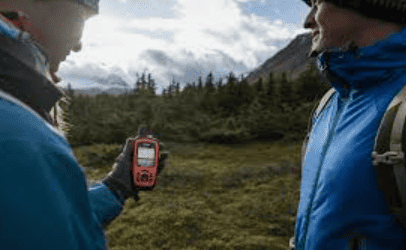
21. Sunglasses:
Quality sunglasses with UV protection shield your eyes from harmful sun rays and reduce glare, enhancing visibility and preventing eye strain during hikes in bright conditions. They are essential for eye health and comfort on sunny trails.
22. Hat:
Wearing a hat provides protection against sun exposure, keeps your head cool, and shields your face from direct sunlight. No one wants to get a bad sunburn. It also helps reduce your risk of overheating, making it an essential accessory for hikers.
23. Gloves:
Depending on the weather and trail conditions, lightweight gloves can provide protection and enhance grip during challenging hikes. They protect your hands from rough surfaces, thorny vegetation, and offer a layer of warmth during cold weather hikes.
24. Portable Water Filter or Purifier:
If you’re hiking in areas with water sources, carrying a portable water filter or purifier allows you to safely drink from streams or lakes. It removes bacteria, protozoa, and other contaminants, providing access to clean drinking water.
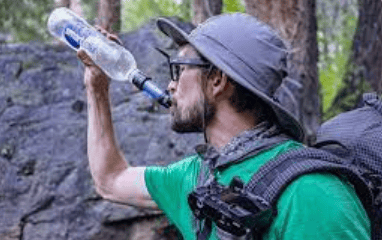
25. Water Bladder or Hydration System:
A water bladder or hydration system allows easy access to water while on the move. It is a convenient way to stay hydrated without needing to stop and retrieve water bottles from your backpack.
26. Water Treatment Tablets:
Water treatment tablets, such as chlorine or iodine tablets, are useful backups when no other water filtration options are available. They help purify water by killing harmful microorganisms, making it safe for consumption during emergencies.
27. Personal Locator Beacon (PLB) or Satellite Messenger:
For remote or challenging hikes, carrying a PLB or satellite messenger can be a lifesaver. These devices allow you to send emergency distress signals, notifying rescue authorities of your location and ensuring help can reach you in critical situations.
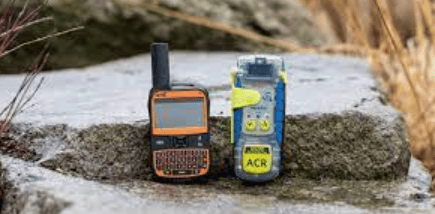
28. Extra Batteries:
Carry spare batteries or a portable power bank to ensure the uninterrupted use of electronic devices, headlamps, or GPS devices. It ensures backup power when needed, keeping your essential devices functional throughout your hike.
29. Waterproof Dry Bags:
Protecting your gear and electronics from rain or accidental water exposure is crucial. Waterproof dry bags keep your belongings dry and secure, allowing you to confidently cross streams or hike in wet conditions.
30. Trekking or Hiking Pants:
Durable and quick-drying trekking or hiking pants offer protection from vegetation, insects, and harsh terrain. They provide comfort, and mobility, and often come with features like zip-off legs for versatility in changing weather conditions
31. Moisture-Wicking Base Layer:
Wearing moisture-wicking base layer clothing helps regulate body temperature by keeping you dry and comfortable. It wicks away sweat, reducing the risk of chafing and ensuring optimal body temperature control during strenuous hikes.
32. Insulated Jacket:
An insulated jacket provides warmth and insulation in colder weather conditions or at higher altitudes. It traps body heat and prevents heat loss, keeping you comfortable and protected from chilly temperatures.
33. Rain Pants:
Along with a waterproof jacket, rain pants offer full-body protection against rain, wind, and wet trail conditions. They keep you dry and prevent water from seeping through, ensuring comfort and maintaining your body temperature.
34. Gaiters:
Gaiters are protective coverings worn over hiking boots to prevent debris, mud, or snow from entering your footwear. They keep your feet and lower legs dry, clean, and shielded from potential irritants encountered on the trail.
35. Insulated Water Bottle Cover:
Insulated water bottle covers or sleeves help regulate the temperature of your drink, keeping it cool on hot days or preventing it from freezing in colder climates. It ensures your hydration remains at an optimal temperature throughout your hike.
36. Food Storage Containers:
Packing food storage containers, such as lightweight and collapsible containers or zip-lock bags, allows you to store leftover food, organize snacks, or keep perishables fresh during your hike.
37. Cooking Stove:
If you plan on cooking meals or boiling water on the trail, a portable cooking stove is essential. It allows you to prepare hot meals and beverages, providing nourishment and comfort during extended hikes or camping trips.
38. Cookware and Utensils:
Lightweight cookware, such as pots, pans, and utensils, are necessary for meal preparation on the trail. Opt for compact and durable options that are easy to carry and clean.
39. Bear Canister or Bear Bag:
In areas with bears or other wildlife, you must store your food in a bear canister or use a bear bag to hang them from a tree branch. It helps prevent animals from accessing your food and reduces the risk of wildlife encounters.
40. Camping Tent:
If you plan on overnight hiking or camping, a reliable and lightweight tent provides shelter and protection from the elements. Look for tents designed for backpacking with easy setup and suitable weather resistance.
41. Sleeping Bag:
A high-quality sleeping bag keeps you warm and comfortable during overnight trips. Consider the temperature rating, weight, and packability when choosing a sleeping bag that suits the climate and duration of your hike.
42. Sleeping Pad:
A sleeping pad provides insulation and cushioning, enhancing your sleeping comfort while protecting you from the cold ground. It helps regulate body temperature and minimizes pressure points, promoting a restful night’s sleep.
43. Pillow:
Although not essential, a compact and lightweight camping pillow can significantly improve your sleeping comfort on overnight hikes.
44. Camping Chair or Seat Pad:
Resting and taking breaks during hikes is important for recharging. A camping chair or seat pad provides a comfortable spot to relax, have meals, or enjoy scenic views, adding a touch of comfort to your outdoor experience.
45. Portable Camp Stove:
For extended backpacking trips, a portable camp stove is ideal for cooking meals efficiently and safely. Look for lightweight and fuel-efficient models that suit your cooking needs and can withstand outdoor conditions.
46. Fire Starter Tools:
Besides matches or lighters, additional fire starter tools such as fire starters, tinder, or fire cubes can make starting a fire easier, particularly in challenging weather conditions or when dry wood is scarce.
47. Camping Cookware Set:
A complete camping cookware set includes pots, pans, plates, bowls, and utensils necessary for cooking and serving meals. Look for lightweight and durable materials that are easy to clean and pack.
48. Camping Mug or Cup:
A dedicated camping mug or cup is useful for enjoying hot beverages, soups, or meals on the trail. It provides insulation, durability, and a comfortable grip, enhancing your outdoor dining experience.
49. Camping Bowl:
A lightweight and sturdy camping bowl is essential for enjoying meals, soups, or snacks. Bowls that are easy to clean, stackable, and made from durable materials are the best.
50. Camping Utensil Set:
A compact camping utensil set with a fork, knife, and spoon allows you to enjoy meals with ease and convenience while minimizing waste from disposable utensils.
51. Camping Plate:
A lightweight camping plate is useful for serving meals and enjoying outdoor dining. Plates that are durable, easy to clean, and stackable for efficient packing are the best.
52. Collapsible Water Container:
A collapsible water container allows you to carry a larger water supply when needed, such as during extended hikes or when camping in remote areas with limited water sources.
53. Water Purification System:
In situations where water sources may be contaminated, a reliable water purification system, such as a filter, purifier, or water treatment tablets, ensures safe drinking water, reducing the risk of waterborne illnesses.
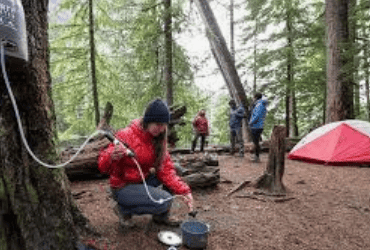
54. Portable Shower:
A portable shower system, whether a solar shower or a lightweight shower bag, allows you to maintain personal hygiene by providing a refreshing wash after long hikes or camping trips.
55. Biodegradable Soap:
To minimize environmental impact, using biodegradable soap for personal hygiene and dishwashing is essential. It ensures that any soapy water or residue does not harm the surrounding nature.
56. Towel:
A compact and quick-drying camping towel is useful for drying off after swimming, bathing, or cleaning. Look for lightweight and absorbent options that take up minimal space in your backpack.
57. Personal Toiletries:
Bring personal toiletries such as toothbrushes, toothpaste, soap, and toilet paper to maintain cleanliness and hygiene during your hiking or camping adventure.
58. Hand Sanitizer:
Carrying hand sanitizer or wipes helps maintain cleanliness and hygiene, especially when soap and water are not readily available. It helps minimize the risk of illness and promotes good hand hygiene on the trail.
59. Lightweight Camping Chair:
A lightweight camping chair provides portable seating if you enjoy sitting comfortably around the campfire or at the campsite. We like ones that are compact and easy to set up
60. Hammock:
For relaxation or an alternative sleeping option, a lightweight and durable hammock is a great addition to your hiking or camping gear. It provides a comfortable spot to rest, nap, or enjoy the surroundings.
61. Trekking or Hiking Poles:
Trekking or hiking poles offer additional stability, support, and balance during hikes, particularly on challenging terrain or when carrying a heavy backpack. They reduce strain on your joints and enhance your overall hiking experience.
62. Extra Shoe Laces:
Carrying spare shoelaces can be a lifesaver if your current laces break or wear out during your hike. They allow you to quickly replace damaged laces and continue your journey without discomfort or inconvenience. In addition, they can be used for 100’s of practical applications.
63. Waterproof Stuff Sacks:
Waterproof stuff sacks help organize and protect your gear from moisture, ensuring that essential items, clothing, or electronics stay dry and secure, even during rainy or wet conditions.
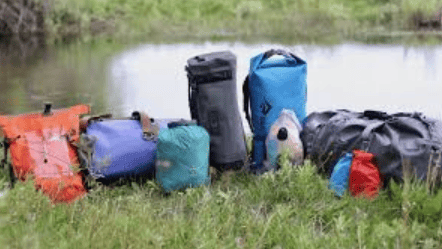
64. Carabiners:
Carabiners are versatile and handy tools for attaching gear, securing items to your backpack, or hanging equipment. They offer convenience and flexibility for organizing your gear and keeping essentials within reach.
65. Rope or Cord:
Packing lightweight and durable rope or cord comes in handy for various purposes, such as setting up a clothesline, securing gear, hanging food away from wildlife, or creating emergency shelters or repairs.
66. Repair Kit:
A small repair kit consisting of items like duct tape, a sewing kit, safety pins, and zip ties allows for on-the-spot repairs to gear, clothing, or equipment, ensuring that you can resolve minor issues and continue your hike with minimal disruption.
67. Waterproof Pack Cover:
A waterproof pack cover protects your backpack and its contents from rain or water splashes, keeping everything dry and secure, even during wet weather or river crossings.
68. Camping Lantern:
A lightweight and compact camping lantern provides illumination in and around your campsite. It ensures visibility for cooking, reading, or navigating during nighttime activities, creating a cozy ambiance in the wilderness.
69. Camping Stool:
A portable camping stool offers a comfortable and elevated seating option for relaxing around the campfire or at the campsite. Look for lightweight and foldable options that are easy to carry and set up.
70. Camping Table:
A compact and lightweight camping table provides a stable surface for cooking, eating, or organizing gear at the campsite. It enhances convenience and comfort during mealtime and other camp activities.
71. Portable Camping Grill:
If you enjoy grilling food while camping, a portable camping grill is a fantastic addition. Look for compact and lightweight options that are easy to assemble and offer cooking versatility.
72. Firewood:
When camping in designated areas where campfires are permitted, bringing firewood is essential for warmth, cooking, and creating a cozy campfire ambiance. Check local regulations and purchase firewood responsibly.
73. Fireproof Gloves:
Fireproof gloves protect your hands when tending to campfires or handling hot objects. They offer heat resistance and dexterity, ensuring your safety while enjoying the warmth and cooking benefits of an open fire.
74. Portable Bluetooth Speaker:
This is for fun if you enjoy listening to music at camp. A Bluetooth speaker works best.
75. Field Guides:
Carrying field guides specific to the region or ecosystem you’re hiking in adds educational value to your trip. They provide information on local flora, fauna, bird species, or geological features, enhancing your understanding and appreciation of the natural environment.
76. Tripod:
A compact and lightweight tripod provides stability for your camera or smartphone, allowing you to take steady shots, time-lapse videos, or self-portraits during your hikes. It adds versatility to your photography and ensures professional-quality results.
77. Binoculars:
Binoculars allow you to observe wildlife, admire scenic views, or appreciate distant landmarks during your hiking journey. They enhance your visual experience and add a sense of adventure to your outdoor exploration.
78. Bird Identification Guide:
If you’re interested in birdwatching, a bird identification guide helps you identify different bird species you encounter on the trail. It enhances your appreciation for avian diversity and adds a rewarding aspect to your hiking experience.
79. Nature Journal or Notebook:
Keeping a nature journal or notebook allows you to document your observations, thoughts, or sketches of plants, animals, or landscapes encountered during your hikes. It fosters a deeper connection with nature and serves as a personal keepsake of your outdoor adventures.
80. Camera or Smartphone:
Capturing memorable moments and stunning landscapes is a wonderful way to preserve your hiking memories. A camera or smartphone with a quality lens allows you to document your journey and share your experiences with others.
81. Extra Batteries or Power Bank:
To ensure you take advantage of every photo opportunity and run out of battery power, carry extra batteries or a portable power bank for your camera or smartphone. It keeps your devices charged and ready to capture those breathtaking hiking moments.
82. Solar Charger:
A solar charger is necessary for recharging your electronic devices, such as smartphones or GPS devices, while on the trail. It’s a sustainable and convenient way to stay powered up, even in remote areas.
83. Field Guide for Geology:
If you’re interested in learning about the geological features and formations you encounter during your hikes, carrying a field guide for geology provides valuable information. It helps you understand the rocks, minerals, and the geological history of the area, enriching your hiking experience.
84. Trail Journal:
Keeping a trail journal allows you to document your thoughts, emotions, and experiences during your hikes. It serves as a personal reflection tool and provides a record of your journey, capturing the essence of each hike and creating lasting memories.
85. Trekking Maps or Guidebooks:
Detailed trekking maps or guidebooks specific to the area or trail you’re hiking offer valuable insights and information. They provide route descriptions, and elevation profiles and highlight key points of interest, helping you plan and navigate your hikes effectively.
86. Animal Field Guide:
Carrying an animal field guide allows you to identify different animal species you encounter on the trail. It adds excitement and knowledge to your hikes, helping you appreciate the diverse wildlife and their behaviors in their natural habitats.
87. Field Guides for Medicinal Plants:
If you’re interested in foraging or learning about the medicinal properties of plants, carrying field guides for medicinal plants helps you identify and understand the uses of various plant species you encounter during your hikes.
88. Nature Photography Guide:
Enhance your nature photography skills by carrying a nature photography guidebook. It offers tips, techniques, and inspiration for capturing stunning images of landscapes, wildlife, and natural phenomena during your hikes.
89. Outdoor Reading Material:
Packing a lightweight book or e-book reader allows you to unwind and relax while immersing yourself in captivating outdoor-themed literature. It provides entertainment during rest breaks or at the campsite, adding a touch of leisure to your hiking experience.
90. Trail App or GPS Navigation App:
Utilizing a trail app or GPS navigation app on your smartphone provides real-time tracking, mapping, and trail information. It helps you stay on course, provides important updates, and enhances your overall navigation experience. These are a must.
91. Solar-Powered Lantern:
A solar-powered lantern offers an eco-friendly and sustainable lighting option for your campsite. It charges during the day using solar energy and provides ambient lighting at night, reducing the need for disposable batteries.
92. Litter Bags:
Practicing Leave No Trace principles is essential for preserving the natural beauty of the outdoors. Carrying litter bags allows you to pack out any trash you generate on the trail, leaving the environment cleaner and more pristine for future hikers.
Remember, this extensive list of essentials covers various items that cater to multiple hiking preferences and conditions. Customize your selection based on the specific requirements of your hike, the environment, and your personal preferences to ensure a safe and enjoyable outdoor experience.



